USAA Life Insurance Review (Coverage Comparisions & More)
FREE Life Insurance Comparison
Secured with SHA-256 Encryption
Compare quotes from the top life insurance companies and save!
| Key Info | Company Specifics |
|---|---|
| Year Founded | 1922 |
| Current Executives | CEO – Wayne Peacock CFO – Laura Bishop |
| Number of Employees | 34,000 |
| Total Sales / Total Assets | $31,100,000,000 / $155,391,000,000 |
| HQ Address | 9800 Fredericksburg Rd. San Antonio, TX 78288 |
| Phone Number | 1-800-531-8722 |
| Company Website | www.usaa.com |
| Premiums Written – Individual Life | $1,024,132,189 |
| Financial Standing | +4.5% from Previous Year |
| Best For | Active-Duty Military Members |
Get Your Rates Quote Now |
|
Purchasing a life insurance policy is one of the most important decisions you can make for your family. However, that decision can be difficult to follow through on if you’re in the military.
Life insurance companies approve and price policies based on how likely they are to pay out on a policy. Many see active-duty military service as too high of a risk. Some of the largest insurers in the country won’t issue policies to current service members.
Fortunately, there are companies willing to assume that risk. Chief among them is USAA, a company that has been serving current and former military members for nearly 100 years.
This review will give you a complete overview of the company and guide you through all of their policy options to help you find the best life insurance coverage for your family.
Start comparing life insurance rates now by using our FREE tool above.
Table of Contents
USAA’s Ratings
The following third-party ratings give insight into USAA’s financial strength, business practices, and quality of customer service.
A.M. Best
A.M. Best ratings measure an insurer’s financial strength and its ability to pay all of its policy obligations.
USAA has the highest possible rating of A++, meaning they have a superior ability to meet their financial obligations.
Better Business Bureau (BBB)
The Better Business Bureau assigns one of 13 letter grades based on factors such as time in business, open complaints, resolved complaints, and federal action against a company.
USAA is not currently accredited by the Better Business Bureau.
Moody’s
Similar to A.M. Best, Moody’s long-term obligation ratings measure an insurer’s credit risk. USAA holds an exceptional Aa1 rating, the second-highest possible.
Standard & Poor’s (S&P)
Standard & Poor’s (S&P) ratings also measure an insurer’s credit risk. USAA has a very strong AA+ rating, the second-highest of 21 overall scores.
NAIC Complaint Index
The National Association of Insurance Commissioners Complaint Index compares the number of complaints registered against an insurer each year with that of other companies.
The NAIC sets the index at an average score of 1.00. USAA has a current score of 0.19, well below the industry standard.
Company History
Military members have traditionally been viewed as a high-risk group by the insurance industry, with many refusing to provide them with coverage.
In 1922, 25 military officers in San Antonio, Texas, gathered together to solve that problem for themselves after being denied auto coverage. They formed a group designed to self-insure each other since nobody else would.
Initially called the United States Army Automobile Association, the group quickly changed its name to United Services Automobile Association once they opened membership to other branches of the military.
Along the way, they also added life insurance, homeowner’s insurance, renter’s insurance, health insurance, banking, investment, and retirement products to their offerings.
In 1996, USAA extended their eligibility beyond just officers to include active duty enlisted personnel, the National Guard, and selected reserves. In 2009, they expanded eligibility again to include all military service members, past and present.
Today, they are the largest financial services provider exclusively serving military members and their families. They have nearly 13 million members nationwide. Along with being one of the largest insurers in the country, they are also the 29th-largest bank.
USAA is currently licensed to sell life insurance policies in all 50 states through its two subsidiaries, USAA Life Insurance Company and USAA Life Insurance Company of New York.
USAA’s Market Share
As of 2018, USAA is the 38th-largest writer of life insurance, with a 0.61 percent market share, representing $1,02 billion in direct written premiums.
| Year | Rank | Direct Premiums Written | Market Share |
|---|---|---|---|
| 2015 | 43 | $948,087,145 | 0.59% |
| 2016 | 42 | $983,626,910 | 0.61% |
| 2017 | 40 | $1,002,979,731 | 0.59% |
| 2018 | 38 | $1,024,132,189 | 0.61% |
Get Your Rates Quote Now |
|||
The numbers here are a little deceiving. At first glance, it appears that USAA is in flux, alternatively falling and rising in market share. However, a look at their direct written premiums and overall rank shows that the company has been steadily increasing its business over the last few years.
Their market share has been rising and falling compared to the industry as a whole, but as an individual company, they are doing better every year.
USAA’s Position for the Future
USAA currently ranks Number 101 on the Fortune 500 list. They have consistently placed on the list for the past 25 years, a trend that is likely to continue far into the future.
On July 26, 2019, The Charles Schwab Corporation announced it would acquire USAA’s investment and brokerage accounts for $1.8 billion, allowing USAA to focus strictly on its banking and insurance businesses.
That injection of cash and increased focus on their core businesses means that USAA will most likely continue to be a top insurer for years to come.
USAA’s Online Presence
USAA offers the ability to pay your premiums and file a life insurance claim on its website.
They also have an active social media presence.
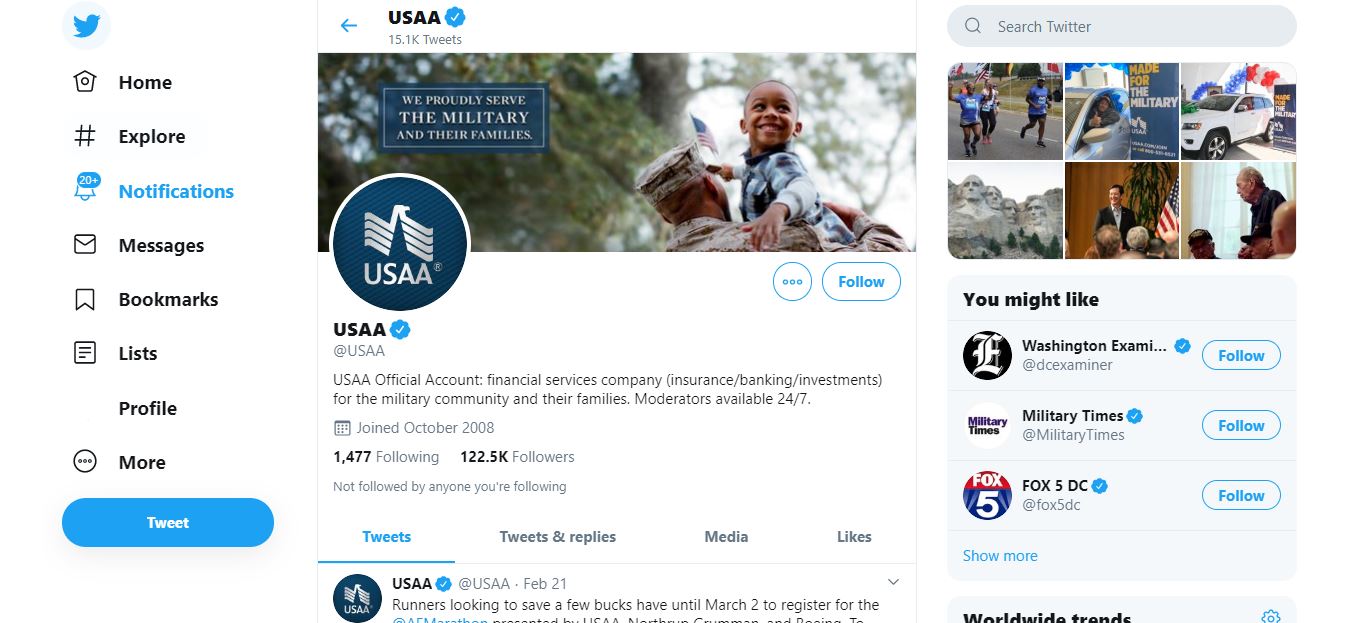
Both their Facebook and Twitter pages are actively updated with information on the company and its offerings.
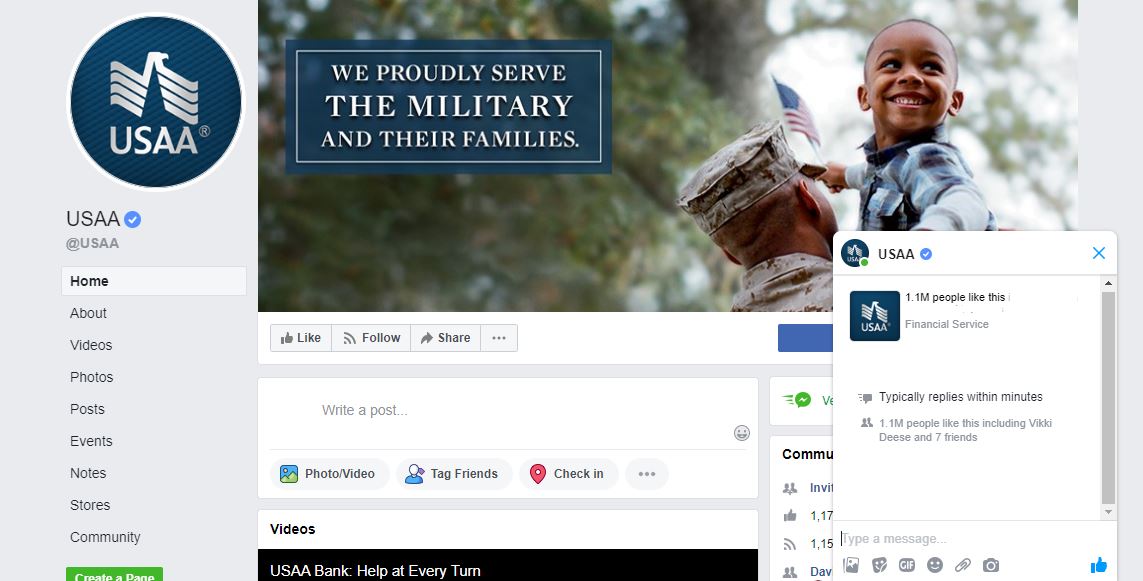
On their Facebook page, you can chat directly with a representative, who can answer any questions you have.
USAA’s Commercials
USAA’s current ad campaign, “Made for,” illustrates how their services are made specifically for service members from all military branches and their families.
Each commercial showcases real, current members of USAA.
USAA in the Community
USAA is committed to giving back to the communities in which it operates. It does so through two areas of focus: national and local.
USAA’s signature cause is military family resiliency. On a national level, they focus on the following areas:
- Military caregivers; families of the fallen; wounded, ill, and injured service members; and military children
- Financial readiness for military families
- Careers for veterans and spouses
On a local level, the focus on the following:
- Programs that address hunger and homelessness
- Science, technology, engineering and math (STEM) education and financial literacy.
- Safety and natural disaster response
USAA pledges millions of dollars and thousands of employee volunteer hours to these causes every year.
The company also operates the USAA Educational Foundation, which provides free financial education materials to the military and the local community for them to be better informed when it comes to making important financial decisions like this one titled Command Your Cash.
The following is an example of one of the foundation’s many video resources:
The USAAEF has a dedicated YouTube channel with dozens of similar videos, all of which are worth checking out if you have any financial questions.
USAA’s Employees
USAA currently employs about 34,000 people.
Glassdoor employee reviews for USAA averaged 3.5 out of five stars based on over 3,000 reviews. A majority 64 percent of current employees say they would recommend the job to a friend.
USAA is currently ranked Number 44 on Fortune’s list of 100 Best Companies to Work For.
Shopping for Life Insurance
If you’re reading this guide, you’ve probably already realized the importance of owning a life insurance policy.
If you’re not sure whether you need life insurance, take a look at these findings from the 2018 Insurance Barometer Study from Life Happens and LIMRA:
- 35 percent of households would be financially impacted within one month of the primary wage earner’s death.
- 90 percent agree that the primary wage earner should carry insurance.
- 60 percent of all people living in the United States have life insurance.
- 20 percent of those with a policy feel their coverage is insufficient.
If you’ve decided to purchase life insurance, here are some things to consider while you shop for a policy.
In general, life insurance should cover two types of obligations: immediate and future.
Immediate obligations are the things that need to be paid soon after your death. These include:
- Funeral costs
- Medical bills
- Mortgage balances
- Personal loans
- Credit card debt
Future obligations are all of the expenses that you want to pay well after your death. They include:
- Income replacement
- Spouse’s retirement
- Children’s college tuition
- Emergency savings fund
USAA offers some advice on determining your coverage needs in the following video:
A life insurance agent can help you determine exactly how much coverage you’ll need to meet all of those obligations, but for now, here’s an example using a simple life insurance calculator.
A husband and father of two is shopping for life insurance. Both he and his wife work full time. He makes $80,000 per year. The family has a remaining mortgage balance of $125,000, a $7,000 balance on an auto loan, and $5,000 in credit card debt.
The mortgage is the largest annual expense. With it paid, his wife will have less need for his income and can survive on her own. So he plans to leave her only five years’ worth of her salary as an emergency savings fund should her financial situation change in the future.
The couple also plans on saving $30,000 to cover the average cost of four years of in-state tuition at a public university for their child.
After factoring in an average funeral cost of around $7,500, the man’s insurance needs are as follows:
- Immediate need – $125,000 mortgage + $7,000 auto loan + $5,000 credit card + $7,500 funeral costs = $144,500
- Future need – $400,000 income replacement + $30,000 college fund = $430,000
- Total need – $574,500
That total means he should purchase a life insurance policy with a face value of around $600,000.
Average USAA Male vs Female Life Insurance Rates
The following table illustrates how USAA’s average annual rates on a 20-year, $100,000 policy in key demographics compare to the average of the top 10 insurers by market share.
| Demographic | Annual Premium – Male | Versus Average Top 10 Insurers | Annual Premium – Female | Versus Average Top 10 Insurers |
|---|---|---|---|---|
| 25-Year-Old Non-Smoker | $135.84 | -$42.70 | $122.88 | -$37.69 |
| 25-Year-Old Smoker | $313.80 | -$7.96 | $264.84 | +$16.09 |
| 35-Year-Old Non-Smoker | $147.84 | -$37.20 | $132.84 | -$33.07 |
| 35-Year-Old Smoker | $404.88 | +$44.65 | $341.88 | +$55.70 |
| 45-Year-Old Non-Smoker | $229.80 | -$38.09 | $189.84 | -$50.41 |
| 45-Year-Old Smoker | $787.80 | +$150.29 | $583.80 | +$90.60 |
| 55-Year-Old Non-Smoker | $422.88 | -$102.07 | $327.84 | -$79.10 |
| 55-Year-Old Smoker | $1,569.84 | +$205.75 | $1,150.80 | +$159.17 |
| Average Non-Smoker | $234.09 | -$55.02 | $193.35 | -$50.07 |
| Average Smoker | $769.08 | +$98.18 | $585.33 | +$80.39 |
Get Your Rates Quote Now |
||||
USAA has premiums that are well below the average for non-smokers, but their policies could be cost-prohibitive for tobacco users.
Coverage Offered
USAA offers term, whole, and universal life options to meet a variety of financial needs. You can also choose from multiple riders to further tailor your policy.
Types of Coverage Offered
Life insurance policies fall into one of two general categories: term or whole.
Term life policies only pay if the death occurs within a set time frame, usually between 10 and 30 years. Whole life policies don’t have any terms. They pay whenever a death occurs, regardless of age.
Some whole policies build cash value by allocating a portion of your premiums into an interest-bearing account.
Many come with two benefit options: fixed and increasing.
With a fixed death benefit, the policy premiums decrease over time as the cash value increases so that the payout is always equal to the initial face value. With an increasing death benefit, the premiums and face value remain the same over time. As the cash value increases, the overall death benefit increases.
The following video from USAA discusses the difference between term and permanent life insurance:
Whole policies have multiple variations: traditional whole life, basic universal life, guaranteed universal life, indexed universal life, and variable universal life.
Term
A term policy is payable only if the death of the insured occurs within a specified period, usually between 10 and 30 years.
Once the term has passed, the insurer cancels the coverage. There are generally no refunds on the premiums paid. Most policies can also be converted to a whole policy before they expire.
USAA covers the basics of term life insurance in the following video:
The specifics of USAA’s term policy are as follows.
- Term – 10, 15, 20, 25, or 30 years
- Flexibility – Face value can be increased or decreased at any time
- Minimum – $100,000
- Maximum – $10 million
- Issue age – 10–60
Active-duty military members receive the following additional benefits:
- Coverage during war
- $25,000 to help with expenses caused by a severe injury
- Guaranteed coverage after leaving the military
Whole
A traditional whole life policy is the most common form of permanent insurance. A portion of your annual premiums is placed in an account that grows at a fixed interest rate (typically around 3–8 percent).
That savings element means the policy has the potential to grow a tax-deferred cash value beyond the face value of the policy, payable to the policyholder.
The cash value can be used to pay premiums, added to the death benefit, or used as supplemental income during retirement.
Whole life is the least risky option when it comes to permanent insurance as you are guaranteed positive growth. Cash accounts that depend on investments have the potential to lose money.
USAA covers the basics of whole life insurance in the following video:
The specifics of USAA’s whole policy are as follows:
- Flexibility – Face amount increases and decreases are permitted, but subject to fees
- Interest – Guaranteed 3 percent
- Minimum – $50,000
- Maximum – $10 million
- Issue age – 18–60
- Payment options – Pay for life, pay for 20 years, pay until age 65
Universal
Universal policies offer the permanent coverage and cash value growth of a traditional whole plan, while also giving you the flexibility to adjust your monthly premiums, change coverage amounts, and make lump-sum payments to keep premiums low over time.
Your cash value grows at a fixed rate, similar to a traditional whole policy. Universal policies offer more flexibility than the traditional option.
The specifics of USAA’s universal policy are as follows:
- Flexibility – Face amount increases and decreases are permitted, but subject to fees
- Interest – Guaranteed 3 percent
- Minimum – $100,000
- Maximum – $10 million
- Issue age – 18–60
- Death benefit option – Level or increasing
FREE Life Insurance Comparison
Compare quotes from the top life insurance companies and save!
Secured with SHA-256 Encryption
Factors That Affect Your Rate
Anything that increases your risk of an early death increases the chances the insurer will have to pay out on your policy. That higher risk classification will result in a higher premium.
Below are some of the most common factors that affect your life insurance costs.
Demographics
Several demographics can have a big impact on your life insurance premiums.
Age: Age is a key factor in determining insurability. The older you are, the closer you are to death. The closer you are to death, the higher the likelihood an insurer will have to pay a benefit.
Waiting to buy a policy will increase your rate year by year. Some insurers also limit coverage amounts for people over certain ages.
Gender: Gender also plays an important role. Statistically, women live longer than men. Because of that, women in the same risk classification typically pay lower premiums than men.
Current Health & Family Medical History
It shouldn’t come as a surprise that healthy people have longer life expectancies than those in poor health. The healthier you are, the lower your risk classification.
To determine your overall health, insurers will require you to fill out a health questionnaire and may request access to your medical records. Some may require a complete medical exam and a blood test.
Some key health measures they look for are obesity, blood pressure, cholesterol, chronic diseases, and drug use.
Even if a policy doesn’t require a medical exam, underwriters still have access to public prescription and Medical Information Bureau (MIB) records, so it’s important to be honest on your application. If your records contradict your application, the insurer could deny your coverage.
Most insurers will also examine the health history of your immediate family to identify any potential hereditary medical issues such as diabetes, a history of heart disease, or cancer.
High-Risk Occupations
Some jobs are more dangerous than others.
The Bureau of Labor Statistics’ Census of Fatal Occupational Injuries shows that police officers, firefighters, construction workers, and others have higher injury risk than many professions.
A dangerous job could mean a higher risk classification and a higher premium.
High-Risk Habits
Similarly, high-risk habits outside of work can also result in higher life insurance rates.
The most common high-risk habit that insurers look for is tobacco use. Smokers almost universally pay higher rates than their non-smoking counterparts in every demographic.
USAA’s rates are over twice as much for smokers at every age.
For example, the average 25-year-old male non-smoker pays around $135 per year for a 20-year, $100,000 policy with USAA. A 25-year-old smoker pays $315 for the same policy.
That works out to an extra $3,600 paid over the life of the plan.
In addition to smoking, insurers will also ask about any other high-risk hobbies, such as racing, flying, skydiving, or any other activity that has a high potential for injury.
A single instance won’t result in a higher rate, but a regularly-occurring hobby probably will.
Veteran or Active Military Status
As discussed in this review, military status falls under the category of high-risk occupations.
Most insurers charge higher rates to active duty military service members, and some don’t sell them policies at all.
Getting the Best Rate With USAA
Your risk classification determines whether an insurer will raise your price from their base premiums. Those base premiums are generally based on three factors: mortality, interest, and company expenses.
Insurers use statistical mortality tables to estimate how many people in every demographic are likely to die each year. If they insure people in demographics with a high likelihood of death, they’ll raise their rates on them to minimize losses.
Rates are also influenced by current interest rates.
Insurers increase their profits by investing the premiums you pay in bonds, stocks, and mortgages. A low expected return on those investments could result in higher premiums.
They also factor in all of their operating expenses. The more a company spends maintaining their business, the more of that cost they pass onto their policyholders.
Rates can also vary from state to state, though the NAIC is currently encouraging states to adopt laws that would provide more uniformity nationwide.
The question is: with so many variables affecting premiums, how do you get the lowest rates?
You can’t change demographics such as gender, and your family’s medical history is beyond your control. Plus, if you’re in the military, you aren’t in a position to simply go get a lower-risk job.
Therefore, the best thing to do is to change the factors you can.
First, make healthy lifestyle changes. Blood pressure level, body mass index, and cholesterol are key measures on a medical exam. You can improve them through diet and exercise. Even a brief, concerted effort could make a big difference on the medical exam.
Also, do some research on the exam process. If you know what they’re looking for, you’ll know what you need to fix.
If you do smoke, stop. Not only should you quit, but you should quit as soon as you can. Most insurers require you to be tobacco-free for a year before you can claim a non-smoking rate. The insurer will verify your abstinence with a blood or urine test.
Second, buy early. The longer you wait to buy a life insurance policy, the older you’ll be once you finally apply. As discussed, older people pay higher premiums.
For example, the average 10-year, $500,000 policy for a 45-year-old male non-smoker at USAA is around $380 per year. That same policy for a 50-year-old costs $565. That five-year jump increases the price by nearly 50 percent.
Lastly, pay your premiums on time. Late payments will result in penalties and could lead to the cancellation of your policy.
If you have a policy canceled for non-payment, you can expect additional fees to get it reinstated, or higher rates at the next insurer.
To give you an idea of how much a term life policy might cost, we’ve compiled a list of average monthly sample rates at USAA for a 10-year term for non-smokers at key ages.
| Age | $100,000 – Male | $100,000 – Female | $250,000 – Male | $250,000 – Female | $500,000 – Male | $500,000 – Female |
|---|---|---|---|---|---|---|
| 25 | $9.49 | $8.74 | $11.86 | $10.20 | $16.65 | $14.99 |
| 30 | $9.49 | $8.74 | $11.86 | $10.82 | $17.07 | $15.40 |
| 35 | $10.15 | $9.49 | $12.70 | $11.65 | $17.90 | $16.24 |
| 40 | $11.32 | $10.32 | $14.57 | $13.53 | $22.07 | $20.40 |
| 45 | $14.24 | $12.65 | $20.82 | $18.53 | $31.65 | $27.90 |
| 50 | $18.57 | $15.32 | $27.28 | $24.36 | $47.07 | $40.82 |
| 55 | $25.15 | $20.07 | $44.57 | $34.15 | $77.90 | $57.07 |
| 60 | $31.07 | $25.99 | $61.24 | $46.65 | $117.48 | $82.07 |
Get Your Rates Quote Now |
||||||
Smokers can expect to pay significantly more than these rates.
USAA’s Programs
USAA’s website includes an advice center with information on a wide variety of topics.
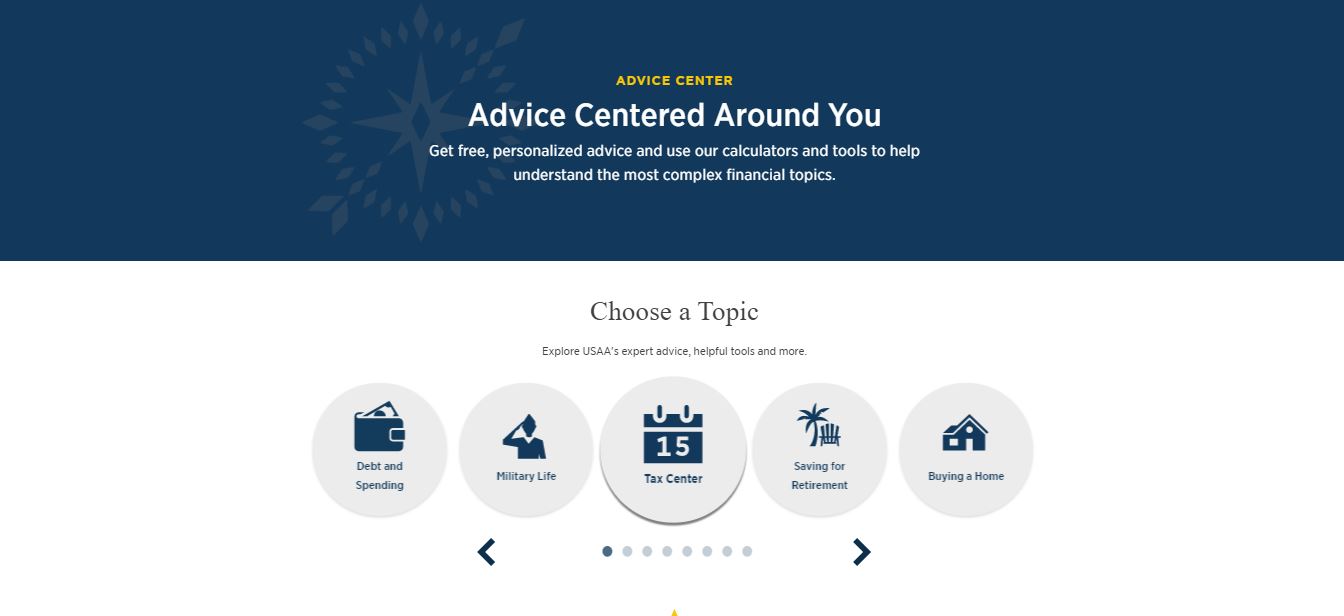
The advice center also includes interactive tools to help you plan your finances, like a budgeting tool and financial readiness quiz.
Canceling Your Policy
USAA’s policies are flexible, but if you do need to cancel your policy outright, you can do so at any time.
There are generally no refunds on premiums when you cancel your life insurance unless you purchase a special rider on some permanent policies.
For a term policy, you would only receive a refund on prepaid premiums for an upcoming period.
How to Cancel
To cancel a USAA life insurance policy, call customer service at 1-800-531-8722.
How to Make a Claim
The overall process of filing a death benefit claim with USAA follows general industry-standard steps:
- Initiate a claim
- Fill out company-specific paperwork
- Submit the paperwork along with a death certificate and any other requested documents
- Choose a disbursement method
- Receive the benefits
To initiate a claim with USAA, call customer service at 1-800-292-8294.
When initiating a claim, you’ll likely be asked to provide a policy number, the insured’s date of death, and a death certificate. If the insurer requires any other documentation, it will be listed in the claim package.
How to Get a Quote Online
Getting an online quote from USAA is simple. In just a few minutes, you can get a quote for either a term or a whole policy.
#1 – Go to the USAA Life Insurance Page
First, go to the USAA website. Choose Products > Life Insurance from the navigation menu.

The quote tool is the first thing you’ll see on the life insurance page.
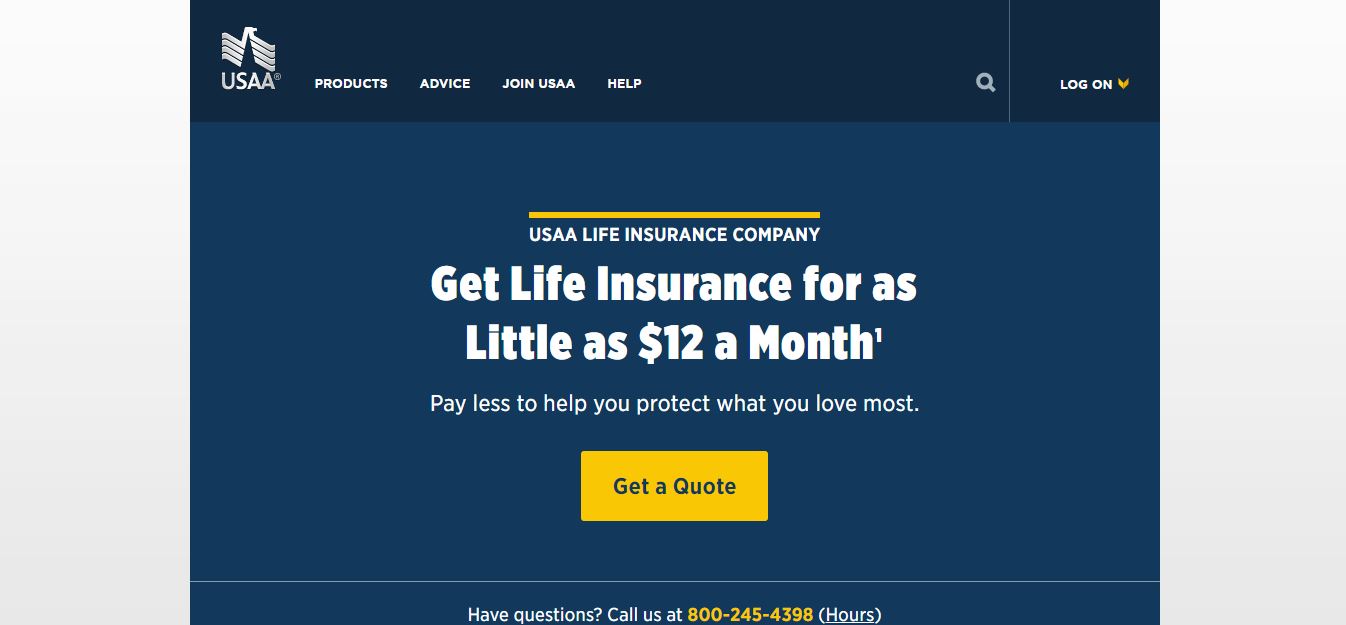
Click Get a Quote to get started.
#2 – Enter Your Demographic Information
Clicking the link will take you directly to the quote tool.
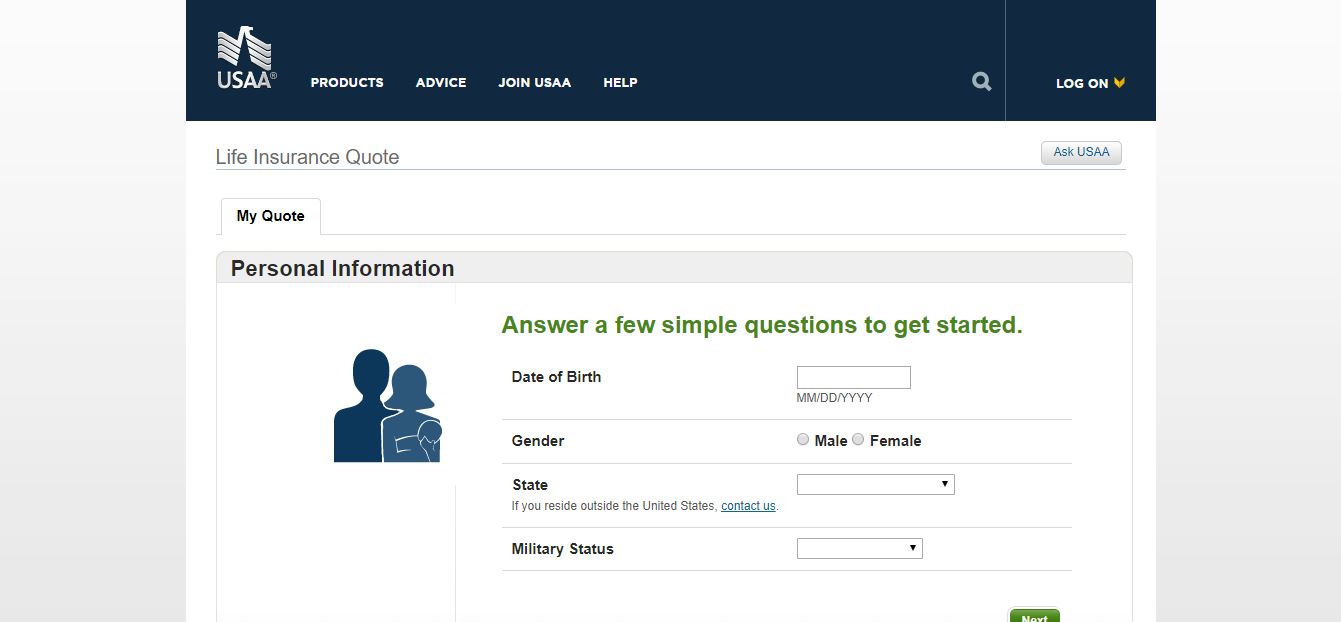
You’ll first be asked to enter some basic demographic information and current military status.
#3 – Enter Your Medical Information
Next, you’ll be asked about your medical history.
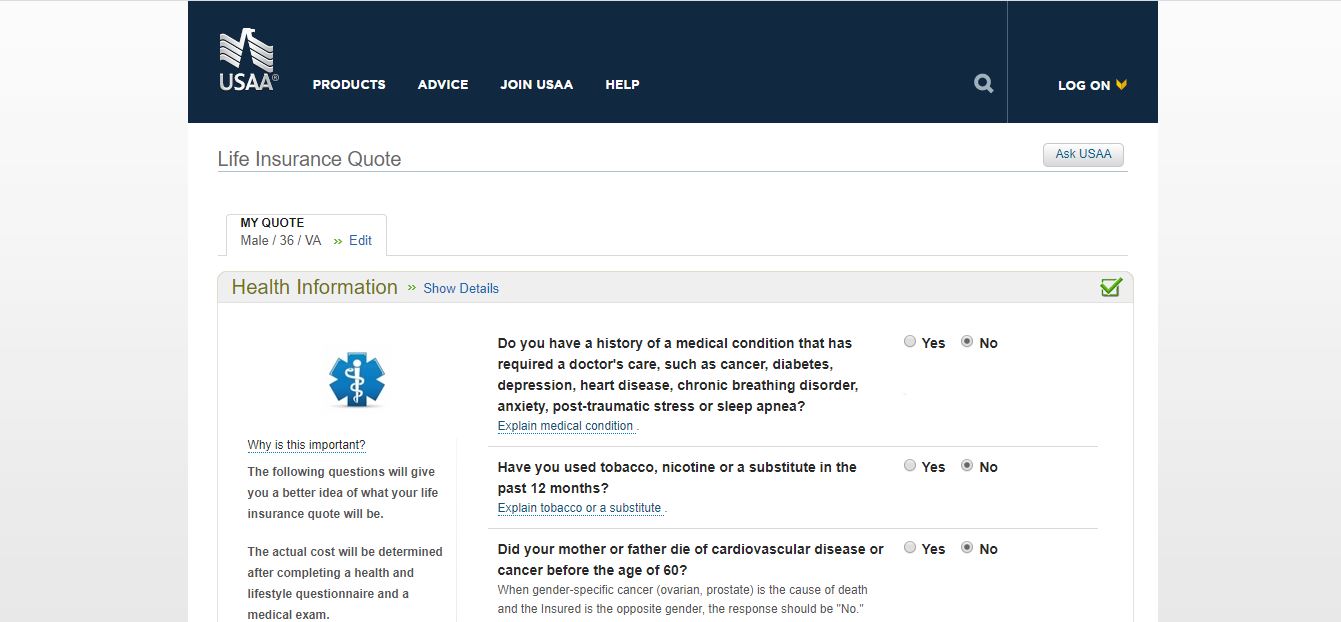
Answer the five simple questions, then click Submit.
#4 – Choose Your Coverage & Get Your Quote
Select your coverage amount. Once you do, the tool will give you an estimated monthly price for a term policy.
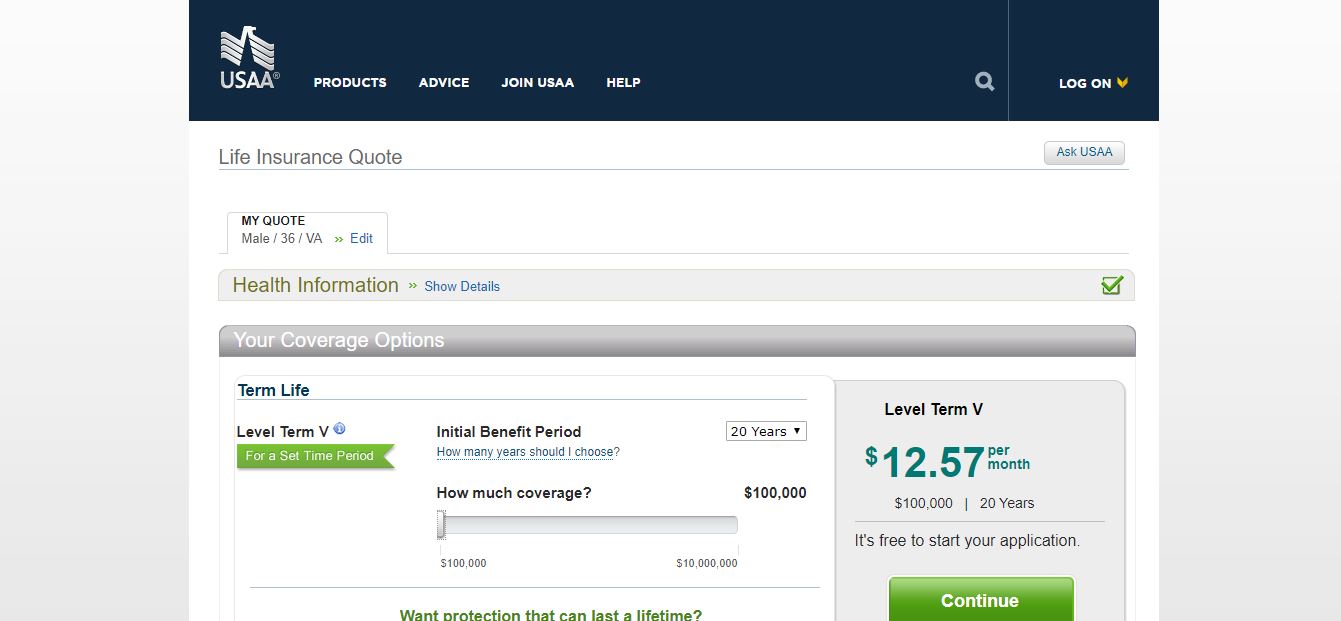
From there, you can choose to add permanent insurance to get an additional quote for either a traditional whole life or universal life policy.
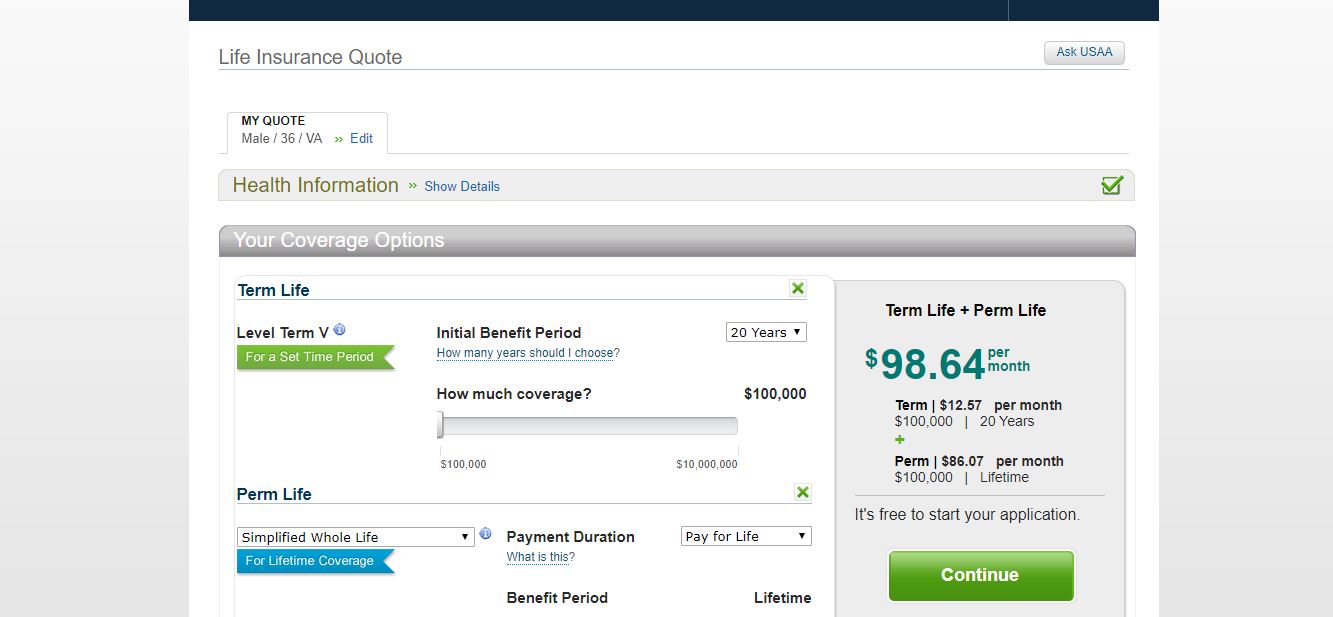
If you like your quote, you can continue on to a full application.
Design of Website/App
The USAA website is well-designed and simple to navigate. The life insurance products are easy to find, but the pages are light on specific information.
The site is designed to give a brief overview of the policies and then guide you to an application, after which a customer service agent will contact you with more specific details.
USAA does have a mobile app, but it is designed exclusively for their banking, investment, and auto insurance products. You can’t use it to manage your life insurance policy. That said, their website is designed for mobile viewing.

Everything on the desktop site is accessible on the mobile site.
Pros & Cons
As with any company, there are pros and cons to shopping with USAA. Here are some of the biggest.
Pros
- Coverage for active-duty and deployed military servicemembers
- Excellent financial ratings
- Below-average rates for non-smokers
- Online quotes
Cons
- Limited coverage options
- Above-average rates for smokers
- Limited additional resources
The Bottom Line
USAA doesn’t have the same wide range of coverage options as some of their larger competitors, but that shouldn’t be a problem for their target market.
USAA isn’t necessarily trying to compete with those bigger insurers. Their products are designed specifically for their niche market: military service members and their families.
So, while USAA might not have the same policy types and riders that the others have, they have the advantage of being one of the few companies that don’t deny life insurance coverage to active-duty military members.
If you or anyone in your immediate family is currently serving, USAA is one of your best options for life insurance coverage. Even with the higher assumed risk, their rates are comparable with the biggest names in the industry.
If you’re no longer serving, USAA is still worth a look. They offer simple coverage for a good price.
This review was designed to give you a comprehensive overview of USAA and their policy offerings. We hope that after reading it, you have all the information you need to decide if USAA is the right life insurer for you and your family.
Did we leave any of your questions unanswered? If so, make sure to read the following FAQs where you may find the answers you need.
Afterward, you can use the FREE quote tool below to instantly compare quotes from multiple insurers.
USAA’s FAQs
Here are some frequently asked questions about USAA and its policy offerings.
#1 – Does USAA offer a no-exam life insurance policy?
USAA prioritizes applications for deploying members. They are fast-tracked through the process and the medical exam requirement is waived. However, that also means they are likely to have higher-than-usual rates since they automatically assume more risk.
Those who get a no-exam deployment policy are encouraged to review their options with USAA after they return home. Taking an exam after the fact could significantly lower the premium.
#2 – Does USAA offer any supplemental coverage?
Yes. USAA currently offers supplemental long-term care coverage, which can be combined with a traditional life insurance policy.
#3 – Can I change my face value?
USAA allows you to adjust your face value during specified periods.
#4 – Can I change my term length?
No. USAA doesn’t allow you to change your term lengths once coverage starts. However, you can convert a term policy to a permanent policy.
#5 – Does USAA offer group life insurance?
No. Because of their military service requirement, USAA does not offer employer-sponsored group life insurance.
#6 – How do I make a payment on my USAA premiums?
You can have your payments automatically debited from your checking account every month by filling out an authorization form or make electronic payments from a savings or checking account online.
#7 – Can I make withdrawals on my USAA insurance policy?
USAA’s permanent insurance policies allow you to take out loans against your cash value. Loans must be paid back with interest, or you risk decreasing or forfeiting your death benefit.
#8 – How easy is it to change my beneficiary?
You will need to fill out a beneficiary change form, which can be filled and submitted directly online or by mail. You can also request a beneficiary change through your sales agent.
#9 – How long does it take for USAA to pay death benefits on a life insurance policy?
Death benefits are typically paid within 30 days of processing the completed claim packet.
#10 – Are the life insurance benefits taxable?
Life insurance benefits are non-taxable when they are paid directly to a beneficiary, such as a spouse or a child. However, if you name your estate as the beneficiary, the benefits are subject to estate taxes.
#11 – Are all USAA insurance policies available in all states?
Yes. USAA is licensed to sell all of its policies in every state through one of its two subsidiaries.
Start Saving on Life Insurance!
Enter your zip code below to compare rates from the top companies in your area
Secured with SHA-256 Encryption



